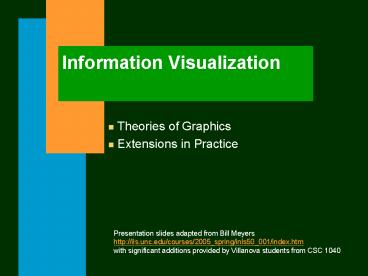Information Visualization PowerPoint PPT Presentation
1 / 31
Title: Information Visualization
1
Information Visualization
- Theories of Graphics
- Extensions in Practice
Presentation slides adapted from Bill
Meyers http//ils.unc.edu/courses/2005_spring/inls
50_001/index.htm with significant additions
provided by Villanova students from CSC 1040
2
Origins of Theory
3
Evolution of Theory
1983 Bertin
Classic Graphics
Computer Graphics
1983 Tufte
1990s Information Visualization
4
Tufte
5
Escaping Flatland
- The essential task of envisioning information,
for all the interesting worldsphysical,
biological, imaginary, or humanthat we seek to
understand, are inevitably and happily
multivariate in nature.
6
3-D or not 3-D
- We see the world in 3 dimensions.
- Most of the information we receive, however, is
acquired in 2-D.
7
3-D Info
- There are numerous ways of displaying information
in 3 dimensions. - Models eg Solar system model
- Stereo images (page 17, Envisioning
Information), one example is a magic eye
picture. - Go to - http//www.magiceye.com/
- 3-D movies/glasses
8
Example Solar System 3D model
Information 4 dimensions
9
Example 3D model of brain
Karen Norberg 1 From the collection in The
Museum of Scientifically Accurate Fabric Brain
Art http//harbaugh.uoregon.edu/Brain/index.htm
10
3-D vs. 2-D
- Displaying information in 3-D directly is fun and
a great way to get information across, but it is
often expensive and hard to do. - 2 dimensional information handling is the most
efficient way to display and gather information
in todays (and yesterdays) world. - Even if it were easy to display information in
3D, that would still not be enough we need more
dimensions!!!
11
Real World Real Information
12
Real World Real Information
13
Source www.dayah.com
14
The Periodic Table
Source http//www.bartleby.com/61/charts/A4elemen
.html
15
Dimensions
- Group
- Period
- Name
- Symbol
- Atomic number
- Atomic weight
- Series
16
Thus... the need for......... Escaping Flatland
2D is not always effective in conveying 3D
information!
17
Escaping Flatland
- ...before something nasty happens!
18
Sharpening Information
- Seeking design strategies to sharpen the
information resolution of paper and video screen
(2-D) - use color, juxtaposition, quality of line, layout
scheme, etc to encode and convey many dimensions
on plane surfaces - increase data density (amount of info. per unit
area) by eliminating non-essential elements
chartjunk
19
First Priority Convey Information
- Charts, tables, diagrams, are all ways in which
data can be represented. - Information presented should be
- visually entertaining
- not simply offered as entertainment.
- You should decide who your audience is and then
try and decide what is the best way to convey
your information.
20
Complicated Information Compacted
21
Galileos telescopic observations
- During the 15th century, Galileo began designing
mechanisms to observe and record the depths of
sunspots (Florence 1610-1612).
http//brunelleschi.imss.fi.it/genscheda.asp?appl
SIMxslbiografialinguaENGchiave300251
22
Galileos Method
- 1. Arrange the telescope facing the sun.
- 2. Place a sheet of white paper over the lenses
- 3. Begin moving the sheet of white paper away
from the lenses, creating a larger, detailed
image. - 4. Note locations of sunspots observe over time
23
Galileos conclusions
- Spots are not distant from the surface.
- Some move rapidly, others slower
- The sun is spherical and it rotates from west to
east. - Spots vary in darkness
- ...move in parallel circles.
24
The Gotti Trial
25
Famous Visual Explanation Pythagorean Theorem
http//www.ams.org/featurecolumn/archive/visual1.h
tml
26
Envisioning Information
- Escaping Flatland
- Micro/Macro Readings
- Layering and Separation
- Small Multiples
- Color and Information
- Narratives of Space and Time
27
Envisioning Information
- "To envision information is to work at the
intersection of image, word, number, art."
28
The Visual Display of Quantitative Information
(1983)
- Graphical Practice
- graphical excellence
- graphical integrity
- Theory of Data Graphics
- data-ink and graphical redesign
- chartjunk vibrations, grids, and ducks
- data-ink maximization and graphical design
- multifunctioning graphical elements
- data density and small multiples
- aesthetics and technique in data graphical design
29
Visual Explanations Images and Quantities,
Evidence, and Narrative (1997)
- Images and Quantities
- Visual and Statistical Thinking Displays of
Evidence for Making Decisions - Explaining Magic Pictorial Instructions and
Disinformation Design - The Smallest Effective Distance
- Parallelism Repetition and Change, Comparison
and Change - Multiples in Space and Time
- Visual Confections Juxtapositions form the Ocean
of the Streams of Story
30
Visualization groupwork
- Each week we will focus on one of the chapters in
Envisioning Information - Working with your group, you will have
approximately 40 min to complete a class activity
(an exercise related to the current chapter) - One group will act as leaders collecting and
combining information from other groups - Lead group makes brief presentation in the
following week
31
Escaping Flatland Exercise
- Search for an image that contains
multidimensional information (more than 3
dimensions). Be sure to note source. - Specify the dimensions of the information and
what is used to convey each one (eg color,
x-axis, font, etc) - Discuss the images overall effectiveness in
conveying information - Identify chartjunk, if any or supply a second
image that contains a lot of chartjunk - Use a powerpoint presentation to organize this
information - Email your presentation to todays leading group

